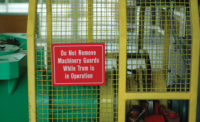Work processes can become more efficient and effective while actually improving workplace safety. Let's take a look at four basic steps to see how.
Step 1: Getting onboard
The designated safety professional will need to educate and convince the "powers that be" as to why he or she should be a viable member of a review process. This will reduce the chances of intervening battles that generally ensue when upper management dictates a top-down decision affecting what insiders consider sensitive departmental domain issues.
Proactive planning prior to machine or equipment installation, assembly or construction can mitigate losses of all kinds. Detailed attention upfront can result in significant savings in time, money and future losses related to incidents or illnesses. Without adequate input from the safety pro, an employer cannot realize the value of providing a safe and efficient work environment, nor a profitable product that meets customers' expectations.
Step 2: Standards and specs review
Once accepted, the safety pro or practitioner's first responsibility is to assist other functional groups through the voluminous documents and resources that contain an ever-growing list of standards and codes. This can include federal and state OSHA regulations and guidelines issued by such groups as the National Fire Protection Association (NFPA) and the American National Standards Institute (ANSI). At times, some members, but not all, may easily identify these sources. Here, the safety pro needs to provide appropriate support in identifying use of these resources for review members.The safety professional's goal should not be to make all members completely conversant regarding codes and standards but to reduce them to a manageable progression that will ultimately lead to safer designs. Even though the relevant documents may be spelled out in a specification (by you, a manufacturer or supplier), helping others acknowledge and apply these standards will limit future problems and reduce the amount of increased costs needed for corrective action "after-the-fact."
Overall, the added benefit of a safety professional's support is that the firm's mission and vision can be more fully embraced.
Once various resources have been reviewed, the next step is to assist in specifying the design requirements. The requirements should be tailored to the particular work environment or process needs. For example, the safety pro may have to help answer the following questions:
1) Will the unit under review be used in inclement weather with definitive extremes?
2) Are there human factor, process safety or industrial hygiene concerns that can affect the operator or other users?
3) Is the failure history of a critical component significant enough to initiate particular changes?
These requirements will have to be addressed in a way that will allow the specification to detail issues that may directly impact safety.
Step 3: Critical design reviews
Within the questions noted in Step 2, the safety pro, working closely with other review members, accumulates and documents any history of significant failures - failures with a given component or with the system in general. This information may help in changing the specification or moving on to the next step. Depending on the project complexity, various reviews may be needed and more formally addressed at 30 percent, 60 percent, or 95 percent review phases as an internal check for all review members and those supporting the project.
If after moving forward a history of failures or inherent weaknesses is discovered, the review group must determine the severity of the deviation and acceptability of risk and potential corrective actions required. If there are concerns, what must the manufacturer or internal department do to notify the committee of discrepancies agreed upon in the original specification? What forms of acknowledgement must be made so that work can proceed with a given design deviation? And can other design variations be made to accommodate the use of a facility or piece of equipment?
Step 4: Final acceptance
Once deviations are accepted and corrective actions made, the next step is to sign-off on the specification and move closer towards hands-on testing and inspection. Unique tools and test equipment may be required along with the special skills of certain subject-matter experts from the review committee.
In addition, users and operators, who are often overlooked during this phase, should be involved in helping with the acceptance of the unit. This ensures a good working relationship with key personnel and proper acceptance or rejection of a product or facility. It also fosters ongoing communications and direct involvement during planning, testing and final acceptance of the desired product.
Dynamic organizations
Each of these four steps can often overlap in some ways, but they allow for the safety professional to work with a suggested method in dealing with the acceptance of tools, machinery, equipment and facilities. It's important to remember that improving machine safety and the physical work environment involves working within very dynamic organizations.Sidebar: Hot buttons
Where machine or facility safety can be improved:
- Industrial shop environments
- Wood/metal working equipment
- Mechanical power transmission devices
- Welding processes
- Chemical or hazardous waste processes
- Cryogenics and compressed gas systems
- Explosives/pyrotechnics
- Painting/blasting operations
- Material handling equipment and devices


